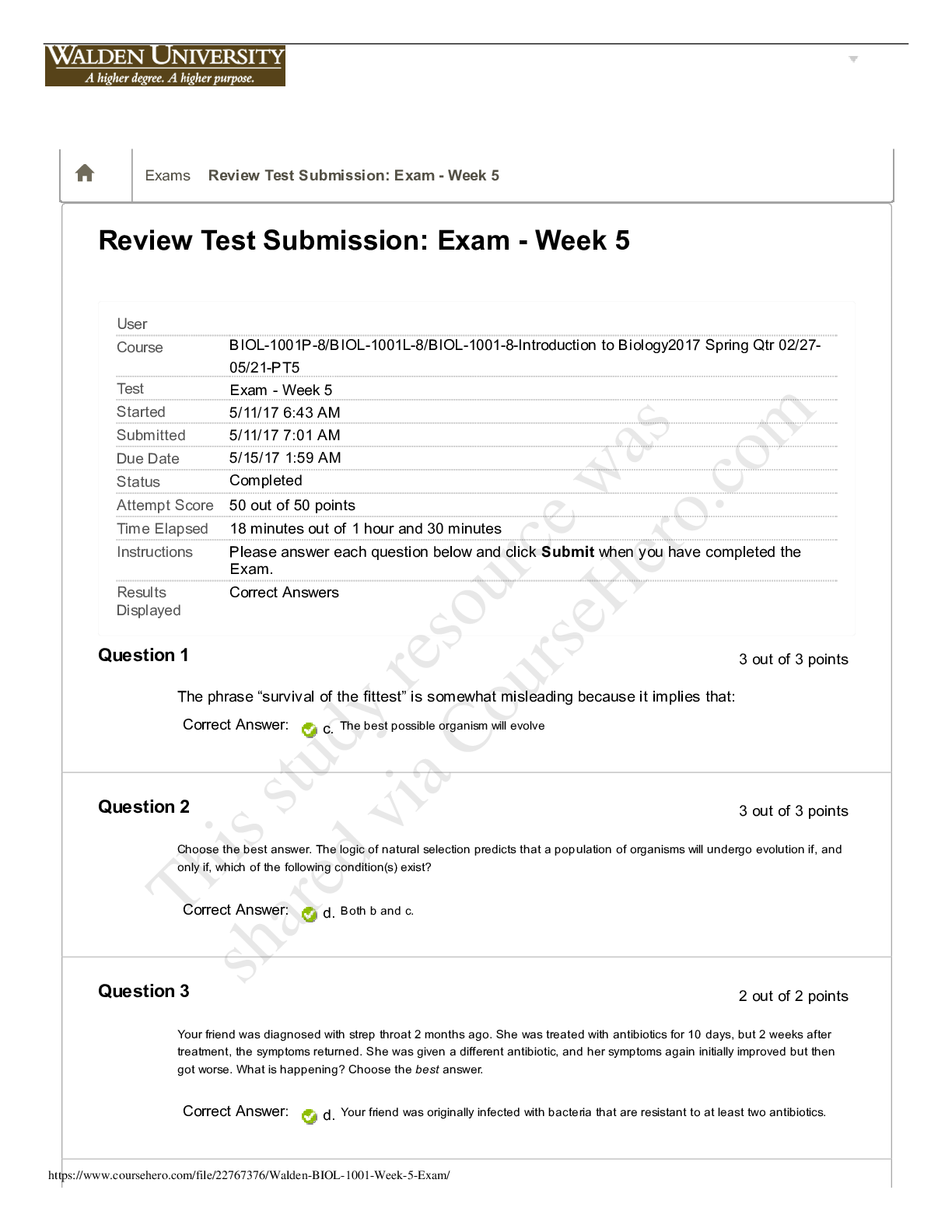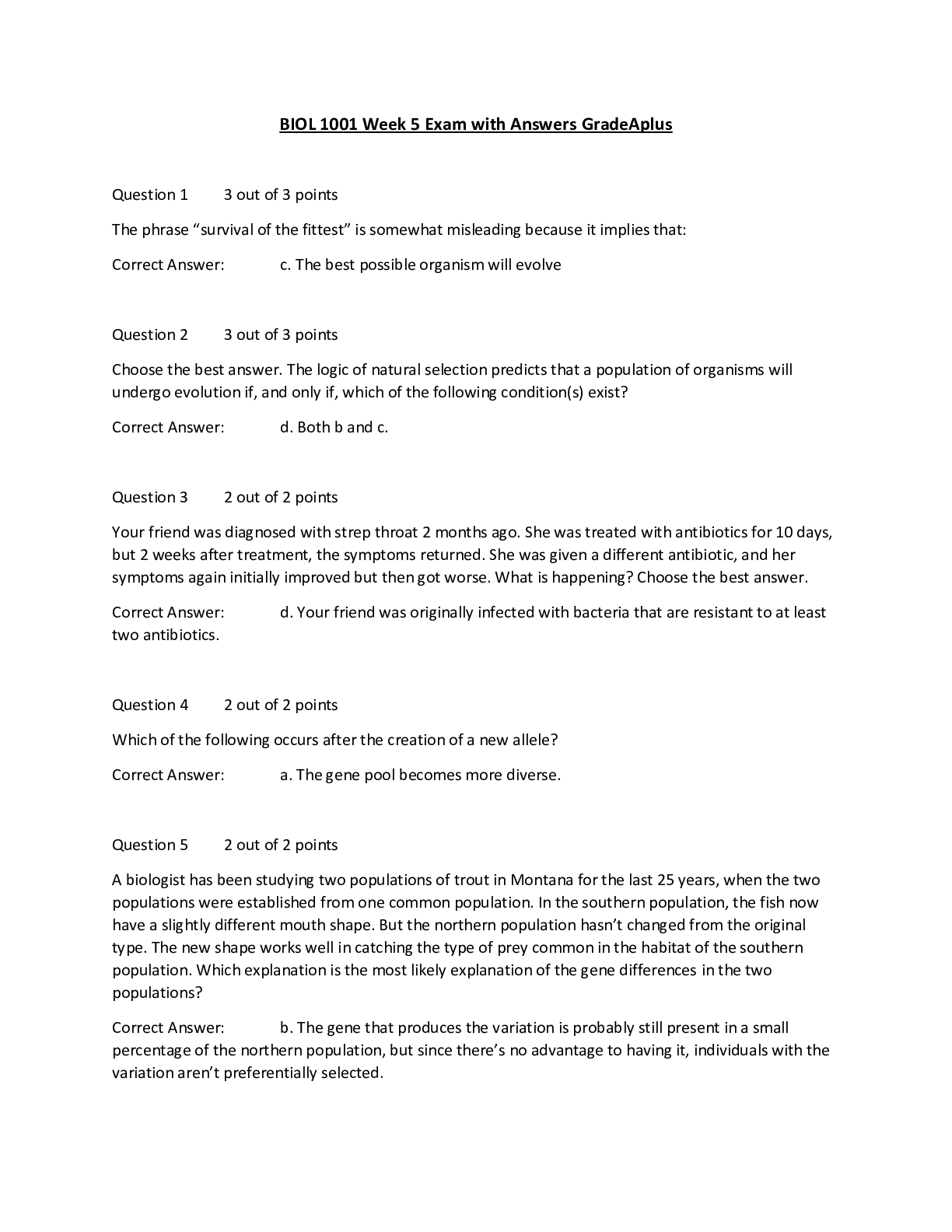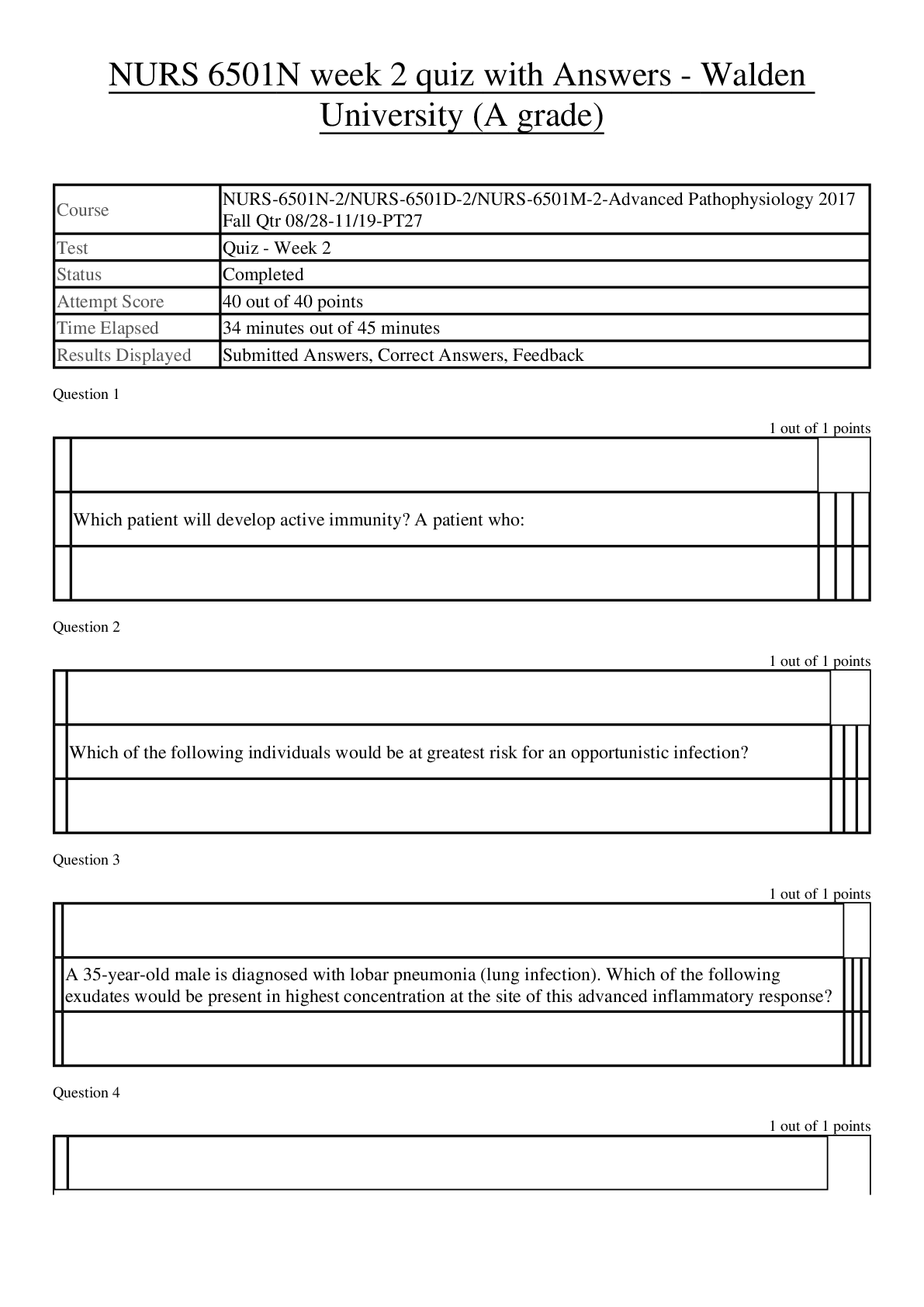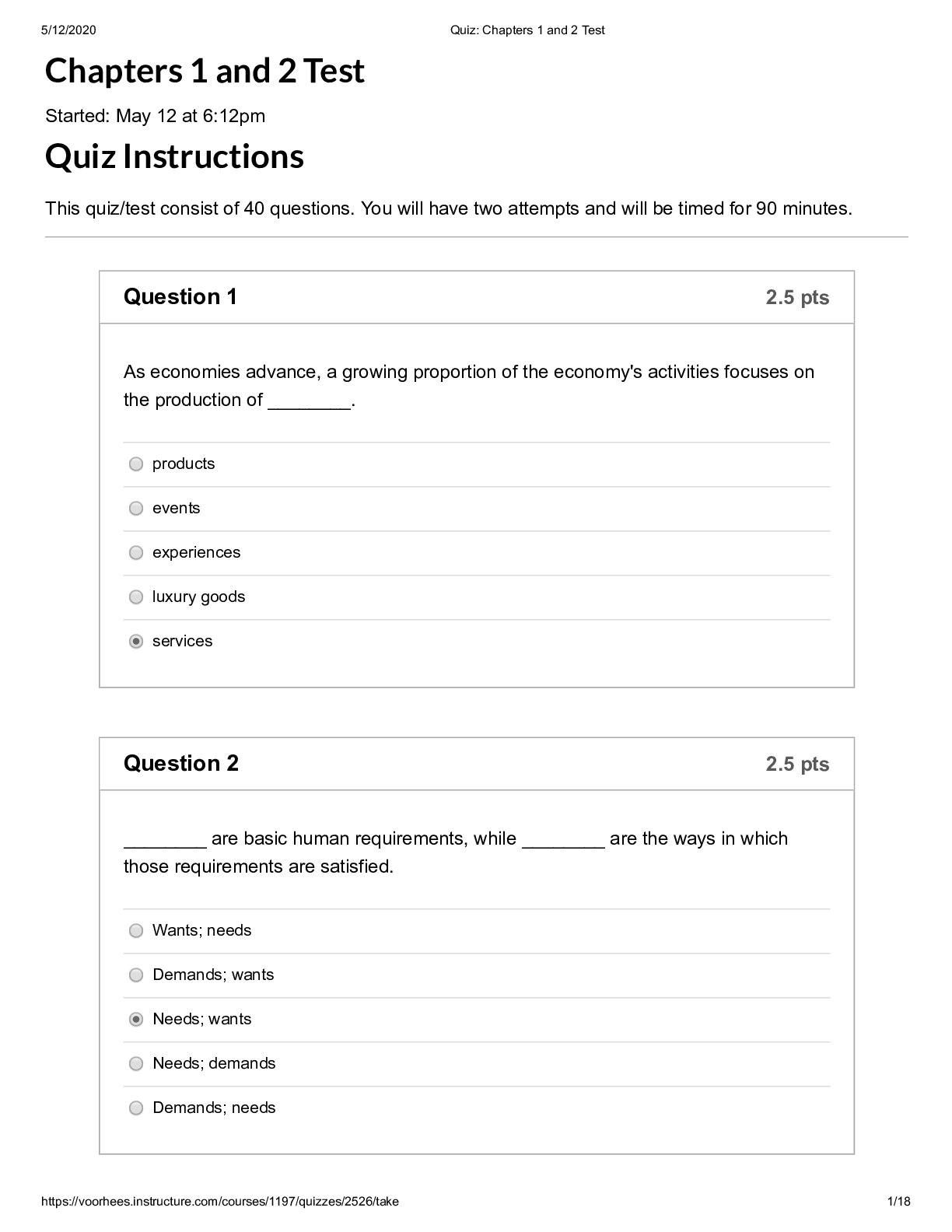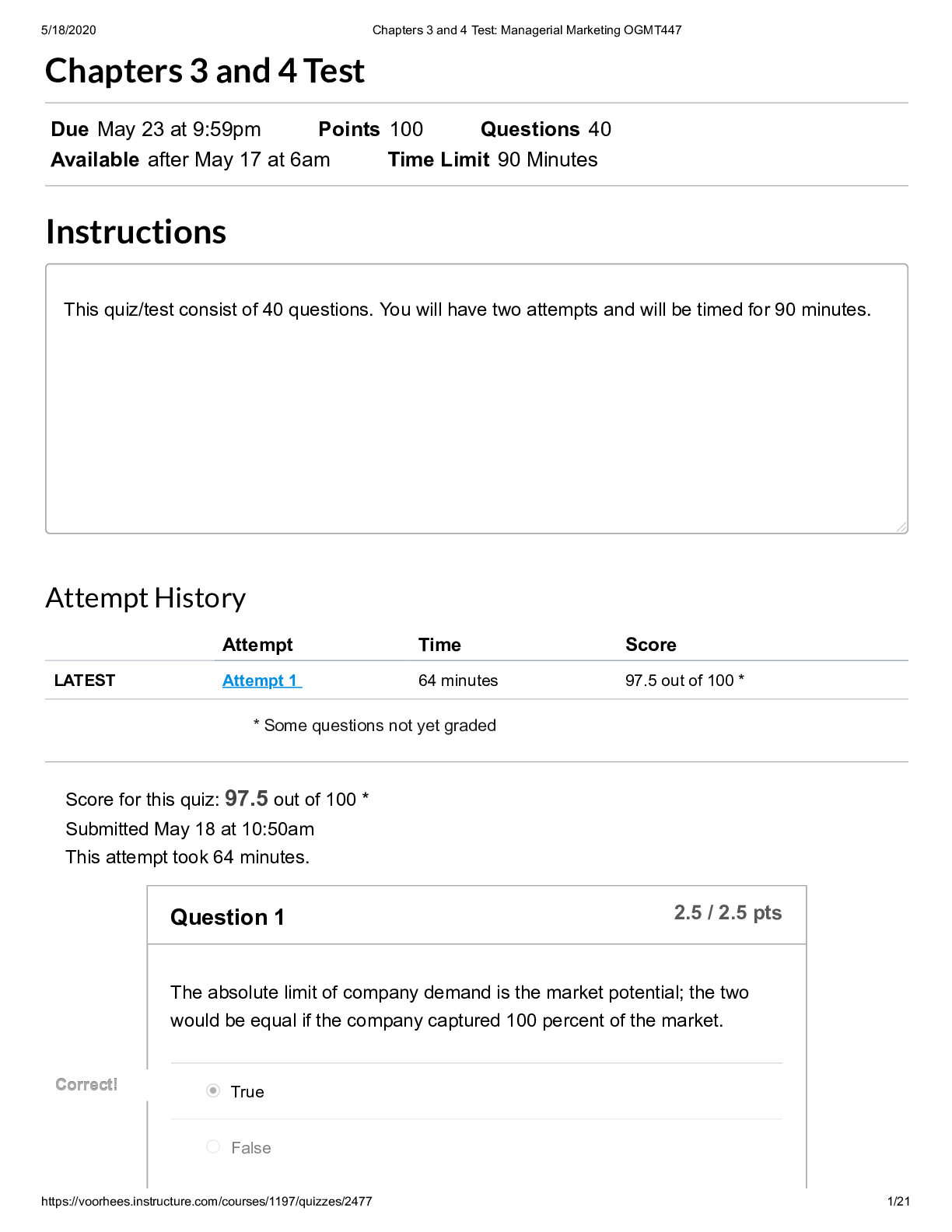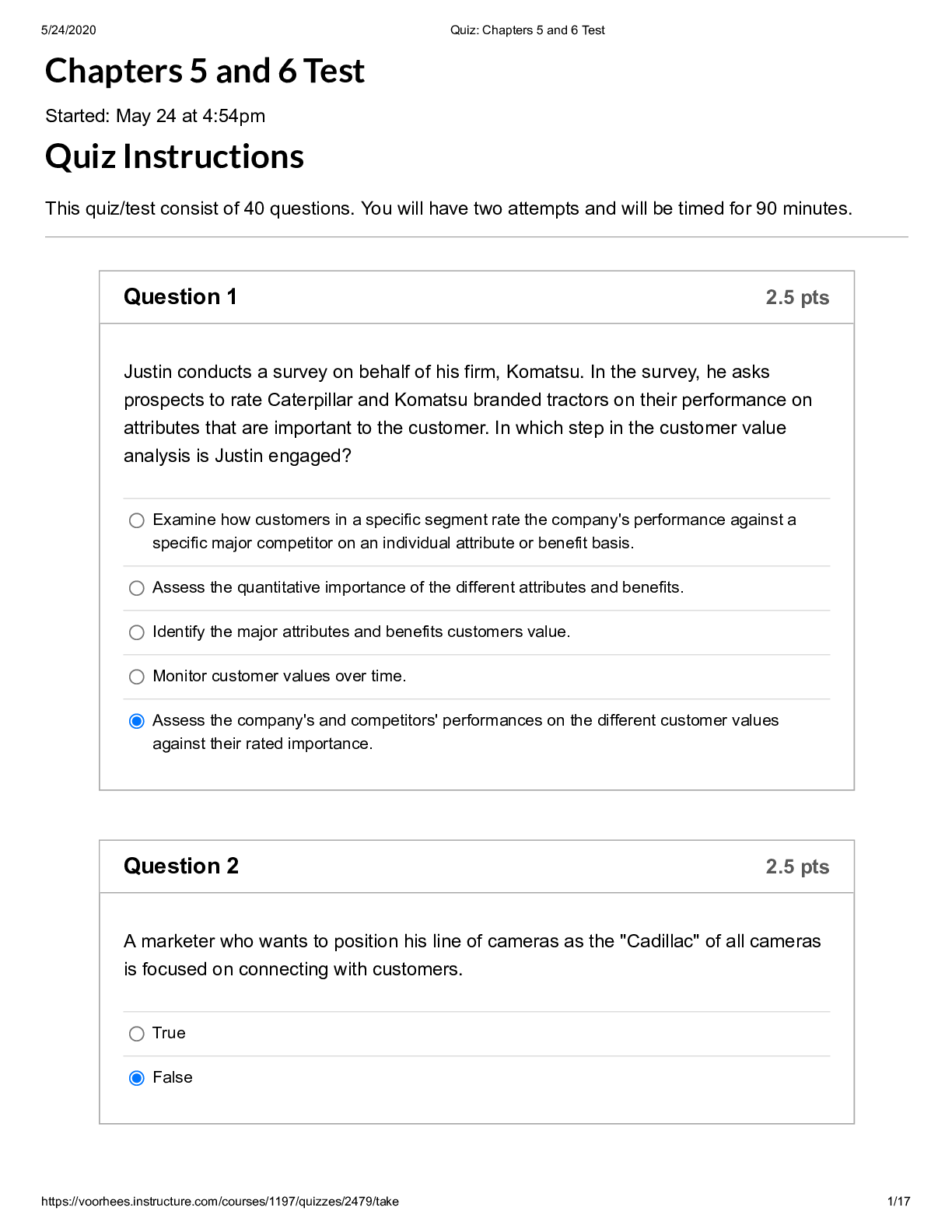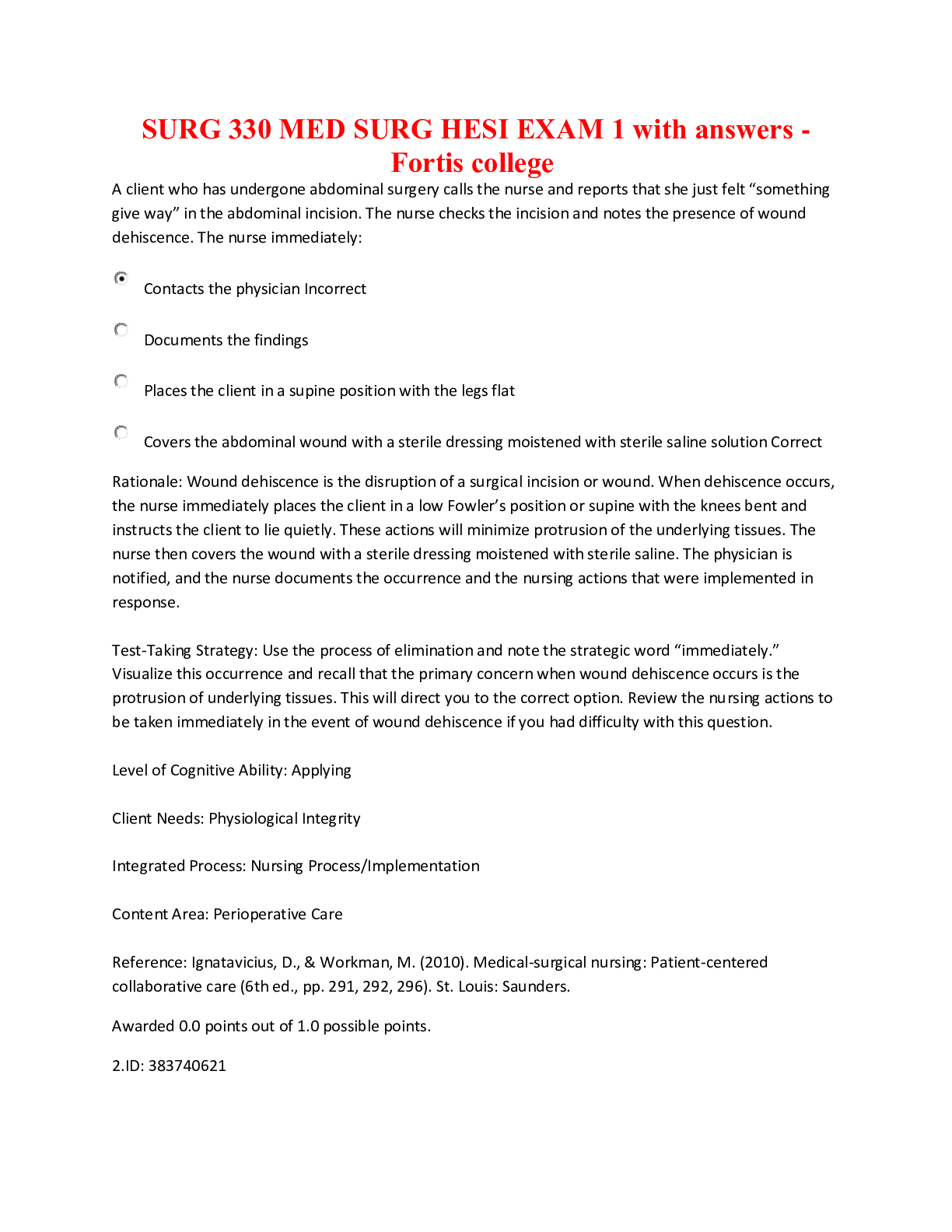*NURSING > EXAM > NR 351 Week 5 exam with answers - Wagner College (A grade) | NR351 Week 5 exam with answers - A grad (All)
NR 351 Week 5 exam with answers - Wagner College (A grade) | NR351 Week 5 exam with answers - A grade
Document Content and Description Below
- - -- - - - NR 351 Week 5 exam with answers - Wagner College (A grade) NR 351 Exam 5 Chapter 38- Oxygenation and Perfusion • Performs its functions through pulmonary ventilation, respi... ration and perfusion • Normal functioning depends on: • Integrity of the airway system to transport air to & from lungs • Oxygenate venous blood; remove carbon dioxide from blood • Properly functioning cardiovascular system to carry nutrients • Upper airway • Function: warm, filter, humidify inspired air • Nose, pharynx, larynx, epiglottis • Lower airway • Function: conduction of air, mucociliary clearance, production of pulmonary surfactant • Trachea, primary and secondary bronchi, and tertiary bronchioles • Anatomy of lungs • Located within thoracic cavity • Right lung: three lobes and 10 bronchopulmonary segments • Left lung: two lobes and 8 bronchopulmonary segments • Lungs are composed of elastic tissue (alveoli, surfactant (low surfactant, alveoli collapse), pleura- fluid between lungs and sac) • Pleural cavity- negative pressure Pulmonary Ventilation- the movement of air into and out of the lungs • Inspiration- the active phase of ventilation- air into lungs • Expiration- the passive phase of ventilation- air out of lungs • Respiration- involves gas exchange between the atmospheric air in the alveoli and blood in the capillaries • Perfusion- the process by which oxygenated capillary blood passes through body tissues Process of Ventilation • During Inspiration • Diaphragm contracts and descends, lengthening thoracic cavity • External intercostals muscles contract, lifting the ribs upward and outward • Sternum is pushed forward, enlarging the chest from front to back • Increased lung volume and decreased intrapulmonic pressure allow air to move from an area of greater pressure (outside lungs) to lesser pressure (inside lungs) • Relaxation of these structures results in expiration Gas Exchange- refers to the intake or oxygen and release of carbon dioxide • Four factors Change in surface area available Thickening of alveolar-capillary membrane Partial pressure Solubility and molecular weight of the gas • Atelectasis- incomplete lung expansion; obstruction of airway by foreign bodies Transport of Respiratory Gases • Oxygen is carried in the body via plasma and RBC’s • Most oxygen is carried by RBC’s in the form of oxyhemoglobin • Hemoglobin carries carbon dioxide in the form of carboxyhemoglobin • Alterations in Respiratory function: Hypoxia- inadequate amount of oxygen available to the cells (can be chronic- headache, chest pain, enlarged heart, clubbing) Dyspnea- difficulty breathing Hypoventilation- decreased rate or depth of air movement into the lungs • Factors affecting Respiratory function Levels of health- acute and chronic illnesses Medications Alteration in muscle function- obesity, scoliosis Cardiovascular System- vital for exchange of gases • Composed of the heart and blood vessels Heart- cone shaped, muscular pump divided into four hollow chambers Upper chambers: receive blood from the veins Lower chambers: force blood out of the heart • Alterations Dysrhythmia or arrhythmia- abnormality to heart rhythm Myocardial ischemia- decrease of oxygen to heart; impaired oxygen to tissues Angina- temporary imbalance of oxygen to heart Myocardial infarction- acute, coronary syndrome characterized by decrease in heart tissue Heart failure- unable to pump sufficient blood supply Respiratory Activity • Infant Lungs go from fluid-filled to air-filled Respiratory rate is rapid (30-55 breaths/min) and primarily abdominal Crackles heard at end of deep respiration is normal • Child Immune system protects from most infections Subcutaneous fat is deposited on the chest wall • Older adult Bony landmarks are more prominent due to fat loss Kyphosis (hump back) Barrel chest- 1:1 AP diameter Increased risk for disease Sounds Heard On Percussion • Resonance- normal lungs • Hyper resonance- emphysematous lungs (normal for child) • Flatness- over bone, heavy muscle (thigh) or tumor • Dullness- the liver or spleen • Tympany- stomach and intestines Breath Sounds • Vesicular- inspiration > expiration, heard over most longs • Bronchial (tracheal)- inspiration < expiration, heard over trachea and larynx • Bronchovesicular- inspiration = expiration, heard over upper anterior chest and intercostals area Abnormal Breath Sounds • Crackles/rales- pneumonia, CHF, bronchitis and COPD Classified as fine, medium or coarse • Wheezes/rhonchi- swelling, secretions, asthma or tumors Classified as sibilant or sonorous Arterial blood gas and pH analysis • pH- 7.35-7.45 • PCO2- 35-45 mmHg • PO2- 80-100 mmHg • HCO3- 22-26 mEq/L Common Diagnostic Methods to assess Cardiopulmonary Function • Echocardiogram- noninvasive sonogram of heart • Endoscopic studies- used to examine larynx, bronchus, trachea- used to see lesions • Holter monitor- noninvasive recording of heart 24-48 hours • Skin tests- TB/PPD • Radiography Values Measured from Pulmonary Function • Tidal Volume (TV) • Vital Capacity (VC) • Forced Vital Capacity (FVC) • Forced Expiratory Volume (FEV) • Total Lung Capacity (TLC) • Residual Volume (RV) • Peak Expiratory Flow Rate (PEFR) Promoting Proper Breathing • Using incentive spirometry • Pursed-lip breathing- sit upright, inhales and count to 3, exhale while tighten abs, count to 7 • Diaphragmatic breathing (COPD)- hand on chest; hand on stomach to guide/push stomach; shallow, rapid, exhausting pattern • Postural drainage- clapping/cupping Types of Cough Medications • Cough suppressants- codeine, dextromethorphan (Dayquil, robitussin); not for productive cough • Expectorants- guaifenisin (robitussin) and adequate fluid intake and air humidification (cold b/c hot may burn child) • Lozenges- benzocaine Selected Medications • Montelukast/Singulair- bedtime for allergies • Benadryl- antihistamine • Zyrtec- antihistamine; don’t use when breastfeeding • Allegra- antihistamine; headache/back pain Administering Inhaled Medications • Bronchodilators- opens narrowed airways • Mucolytic agents- liquefy/get rid of secretions • Corticosteroids- need to weight them if on for a while; monitor BP and blood sugar • Metered dose inhaler and Dry-powder inhalers- should use a space b/c it traps medication inside to fully inhale Oxygen Delivery Systems • Nasal canula • Nasopharyngeal catheter • Face masks: • Simple mask: 02/humidifier- low flow • Partial rebreather mask- reservoir bag- low flow • Nonrebreather mask- delivers highest concentration of 02; can cause suffocation if problem in bag- low flow - - - - - - - - - - - - - - - - •Partial pressure (“P”) - the chemical and physical activities of 2 gases. “a” means arterial –Partial pressure of carbon dioxide PaCO2 Partial pressure of oxygen PaO2 •Low PaO2 =HGB carries less than normal levels of O2, carbonic acid leaves the body in excessive amount •High PaO2 =HGB carries more oxygen; influenced by respiratory activity, excessive carbonic acid in the body Administering Medications • Mineral-electrolyte preparations: correct electrolyte imbalances • Diuretics: drugs that increase excretion of water IV Therapy • Isotonic- same concentration of particles of plasma (275-295) D5W (5% dextrose in water) 0.9% NaCl (normal saline- NS) Lactated Rigers • Hypertonic- greater concentration of particles than plasma (>295) –D5 1/2NS (5%dextrose in 0.45% NaCL) –D10W (10% Dextrose in water) –D5 0.9 (5% Dextrose in 0.9% NaCl- normal saline) • Hypotonic- lesser concentration of particles than plasma (<275) –0.33% NaCl (1/3 NS) –0.45% NaCL (1/2 NS) Types of IV Therapy • Vascular access devices (IV Catheters) Least amount of risk for IV complications; available for delivery of solutions/meds into a vein Three types: Peripheral venous catheters- most common Brief infusion therapy Midline peripheral catheter Inserted peripherally; longer than PVC; not considered central line Central venous access devices (CVAD) PICCs Nontunneled percutaneous central venous catheters (sutured in) Tunneled central catheters (long term use) Implanted ports IV Complications • Phlebitis- inflammation of veins • Air embolus- air in circulatory system respiratory distress • Fluid overload- too much in system engorged neck • Speed shock- too much at once change site, don’t use same vein Administering Blood • Transfusion: infusion of whole blood or a blood component • Indications: blood loss; whole blood transfusions can cause fluid volume overload • Person receiving recipient • Person giving donor • 18 gauge or larger Blood Types: A, B, AB, O; inherited trait determined by antibodies and antigens in blood • Antigen: substance that causes formation of antibodies; on RBCs • A a antigen; B b antigen; AB both a and b; O neither • Antibody: protein substance developed in the body in response to the presence of an antigen that has entered the body • Agglutinin: antibody that causes clumping of antigen • A agg for B; B agg for A; ab NO agg for A or B; O has both • If type O is transfused for A or B, there will be destruction of recipients RBCs b/c antigens will react • AB- UNIVERSAL RECIPIENT; O- UNIVERSAL DONOR • Rh factor: inherited antigen [Show More]
Last updated: 1 year ago
Preview 1 out of 18 pages
Instant download
.png)
Buy this document to get the full access instantly
Instant Download Access after purchase
Add to cartInstant download
Reviews( 0 )
Document information
Connected school, study & course
About the document
Uploaded On
Jan 18, 2021
Number of pages
18
Written in
Additional information
This document has been written for:
Uploaded
Jan 18, 2021
Downloads
0
Views
40













